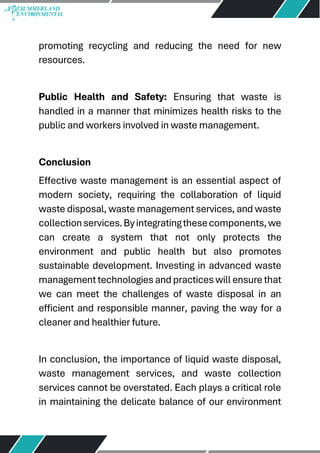5 Easy Facts About Reclaim Waste Described
5 Easy Facts About Reclaim Waste Described
Blog Article
The 3-Minute Rule for Reclaim Waste
Table of ContentsAn Unbiased View of Reclaim WasteNot known Details About Reclaim Waste The Greatest Guide To Reclaim WasteThe Main Principles Of Reclaim Waste The Best Strategy To Use For Reclaim Waste
Discover the types, occurrences, and types of liquid waste. Domestic sewage waste refers to the waste and products from a property septic storage tank. This kind of waste is produced by human beings in homes, schools, and other structures. This only includes septic tanks that have a drain area. The appropriate administration and disposal of domestic sewer waste call for fluid waste to be transferred to a sewage treatment plant where the correct approaches and tools are related to detoxify and throw away waste.
Commercial waste frequently consists of possible hazards, such as flammable products or a combination of liquid and solid waste products, and requires an extra innovative and in-depth disposal procedure. The disposal of industrial waste normally entails the filtering of waste prior to transportation to make sure risk-free and correct disposal. Hazardous waste is produced from byproducts and drainage of commercial procedures and production.
This sort of waste can not make use of the same sewer management transport or procedures as septic or commercial liquids. The hazardous waste administration procedure calls for the assessment and screening of liquid waste before it goes through the disposal process (industrial wastewater treatment). Runoff waste is the fluid waste that comes from overflow and excess stormwater in highly populated locations or cities
Runoff waste can trigger contamination and flooding otherwise taken care of correctly. Discover more regarding sewer cleaning and waste monitoring. Guaranteeing appropriate waste monitoring can avoid disasters and decrease environmental injury. Both people in residential setups and specialists in business or production sectors can benefit from comprehending the procedures and regulations of liquid waste monitoring.
Some Known Details About Reclaim Waste
Get in touch with PROS Providers today to discover our waste monitoring and disposal solutions and the appropriate means to look after the liquid waste you generate.
(https://hub.docker.com/u/reclaimwaste1?_gl=1*1980ev1*_ga*MTgwOTc3Nzc2OS4xNzMxMzI1Mzkw*_ga_XJWPQMJYHQ*MTczMTMyNTM5MC4xLjEuMTczMTMyNTcwOC4xMC4wLjA.)This so-called 'wastewater' is not just a crucial resource yet, after treatment, will certainly be launched to our land, waterways or the ocean. Used water from commodes, showers, bathrooms, kitchen area sinks, washings and industrial processes is understood as wastewater.

water utilized to cool machinery or clean plant and devices). Stormwater, a type of wastewater, is runoff that streams from farming and metropolitan areas such as roofs, parks, gardens, roads, paths and rain gutters into stormwater drains pipes, after rain. Stormwater moves untreated directly to neighborhood creeks or rivers, ultimately reaching the ocean.
Reclaim Waste for Dummies
In Queensland, a lot of wastewater is treated at sewage treatment plants. Wastewater is moved from residential or industrial sites with a system of sewers and pump stations, known as sewage reticulation, to a sewer therapy plant.
The Division of Natural Resources encourages neighborhood governments concerning managing, operating and keeping sewage systems and therapy plants. In unsewered locations, city governments might need owners to install private or home sewage therapy systems to deal with domestic wastewater from commodes, kitchens, restrooms and laundries. The Division of Natural Resources authorises the use of house systems when they are proven to be reliable.
In some new class, treatment of some stormwater to get rid of clutter, sand and gravel has begun utilizing gross toxin traps. Wastewater treatment happens in four stages: Eliminates strong issue.
Utilizes small living microorganisms knows as micro-organisms to break down and remove continuing to be liquified wastes and fine fragments. Micro-organisms and wastes are included in the sludge.
The Ultimate Guide To Reclaim Waste
Nutrient removal is not offered at all sewage therapy plants because it needs costly specialist equipment. It is ending up being more typical in Queensland. Clear fluid effluent produced after treatment may still consist of disease-causing micro-organisms. If this effluent is released into rivers such as rivers or the sea, the micro-organisms will ultimately die out.

This generally suggests wastewater has actually to be treated or contaminants eliminated before it can be released to rivers. The majority of wastewater moves into the sewerage system. Under the Act, neighborhood federal governments provide approvals and permits for eco pertinent activities (Periods) including wastewater launches that might have a neighborhood effect. The department provides authorizations and licences to ERAs entailing wastewater releases that might have a local or statewide influence.
A Biased View of Reclaim Waste
Otherwise, examples are considered laboratory analysis. Frequently many examinations are needed to develop the levels of each of the different pollutants such as oils, heavy steels and chemicals in water. Surveillance provides valid info look at these guys concerning water high quality and can verify that permit problems are being fulfilled. The details acquired via monitoring supplies the basis for making water high quality decisions.
Report this page